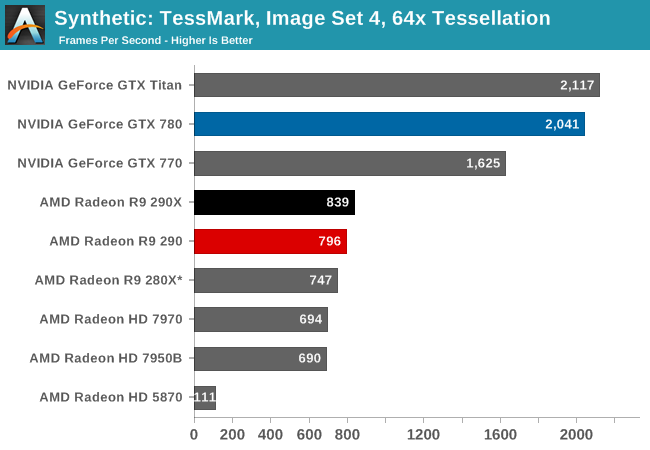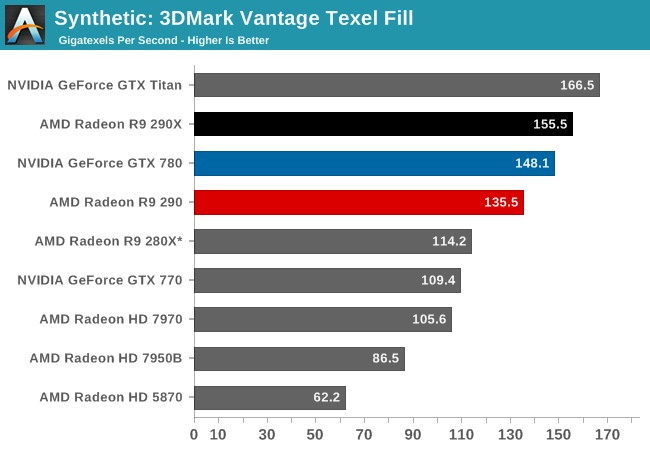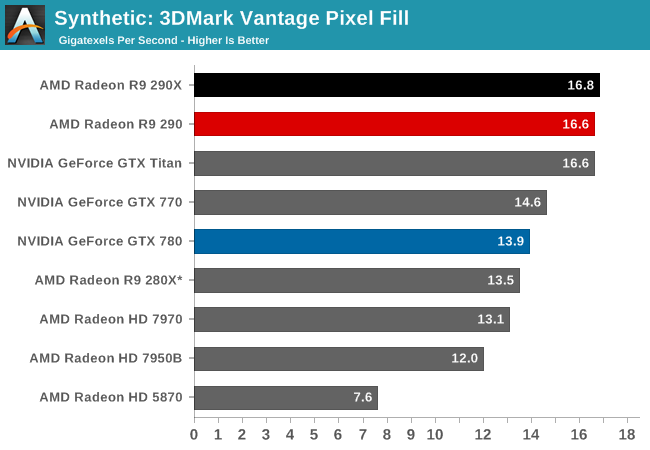The AMD Radeon R9 290 Review
by Ryan Smith on November 5, 2013 12:01 AM EST- Posted in
- GPUs
- AMD
- Radeon
- Hawaii
- Radeon 200
Synthetics
As always we’ll also take a quick look at synthetic performance. The 290X shouldn’t pack any great surprises here since it’s still GCN, and as such bound to the same general rules for efficiency, but we do have the additional geometry processors and additional ROPs to occupy our attention.

Hawaii performance on TessMark continues to underwhelm. 290 should have plenty of performance to create triangles, but it’s apparently having a problem fully utilizing them, a problem NVIDIA does not have.
Moving on, we have our 3DMark Vantage texture and pixel fillrate tests, which present our cards with massive amounts of texturing and color blending work. These aren’t results we suggest comparing across different vendors, but they’re good for tracking improvements and changes within a single product family.

3DMark’s texel fill test is one of a handful of tests where the 290 and 290X are actually separated by as much as the theoretical performance difference implies they should be. Clocked lower and with fewer CUs than 290X, 290 delivers 87% of the texturing performance.

Meanwhile the pixel fill rates show just how close the 290 and 290X can be even under best case circumstances for each card, due to the fact that they have an equal number of ROPs and equal memory bandwidth. Consequently the 290 loses almost nothing for pixel pushing power as compared to its bigger sibling.










295 Comments
View All Comments
mattgmann - Tuesday, November 5, 2013 - link
I'd really like to see some benchmarks with this and the 290x under water.For someone like me that has already invested in building a water cooling setup and seen a few generations of hardware pass through it, the idea of watercooling the graphics card is a foregone conclusion.
The only added cost to me in upgrading the cooling is a few dollars worth of memory and other heatsinks to put on the card since I'd be using a universal gpu block.
I have a feeling that with the thermal levels in check, these cards will probably perform a good bit quicker than they already do (and that much more than the competition).
supamark - Tuesday, November 5, 2013 - link
"At the end of the day the 290 is 9.7dB louder than its intended competition, the GTX 780. With a 10dB difference representing a two-fold increase in noise on a human perceptual basis, the 290 is essentially twice as loud as the GTX 780."Un, no. Learn to dB... 3 dB would mean it's twice as loud, 10 dB means it's 10x as loud, the decibel is a log scale.
NomanA - Tuesday, November 5, 2013 - link
Human audio perception is also on a somewhat logarithmic scale. Twice as loud, doesn't mean, two times a certain value on a linear scale.supamark - Tuesday, November 5, 2013 - link
Sorry, but 3 dB is twice as loud. 10 dB, aka 1 Bel, is 10 times as loud. You hear 3 dB as twice as loud. You should just read this.... (3rd paragraph) instead of arguing.http://en.wikipedia.org/wiki/Decibel
kiwidude - Tuesday, November 5, 2013 - link
You are incorrect, 3dB represents a ratio of two to one or a doubling of power. Perception of loudness is not the same as sound pressure level or power. An increase of 10db SPL is perceived to be approximately twice as loud.I suggest you read instead of arguing. http://trace.wisc.edu/docs/2004-About-dB/
Sancus - Wednesday, November 6, 2013 - link
You're talking about power. Ryan Smith is talking about perceptual loudness. They're completely different. 10db does NOT sound 10 times as loud to your ear. It merely represents ten times as much power.http://trace.wisc.edu/docs/2004-About-dB/
piroroadkill - Wednesday, November 6, 2013 - link
You would need to start talking about human-hearing-weighted scales at that point to get any kind of "X as loud" to us, type measurements. Which is where dBA is often the go to scale.philosofa - Tuesday, November 5, 2013 - link
Don't quote me regulations. I co-chaired the committee that reviewed the recommendation to revise the color of the book that regulation's in. We kept it gray.Excellent editing ser :)
dudeofdur - Tuesday, November 5, 2013 - link
bracket + closed loop water cooler. Boom, solved your problemTorm - Tuesday, November 5, 2013 - link
It is sad when a review is so biased, that the reviewer doesn't appreciate extra performance. If you prefer a quiet card, turn the fan speed down. You are here to review the performance, and while the noise level is taken into consideration, in your final thoughts, you never once say "While the may be loud, you can always adjust fan levels to find the right sound for you." This card, by performance numbers, should have been a very high recommendation, with a note on it being loud. You decided in the review of the card, that you had rather recommend against it, as opposed to being honest. While I tested the card, I found it loud yes, but I also found that if I was an "Average" consumer, who will have their computer case sitting at least 2-3 feet from them, and listening to the audio of a game, movie, or music, that the audio difference between it and the 780 is barely noticed. This is a good review ruined by Biased minded comments. If you are looking for one of the best cards out there, and the BEST value for your money. This card IS it. Bar None. Just to be clear. I am a Hardcore Titan fan, but if I were to build a PC today, this would be the card I went with.